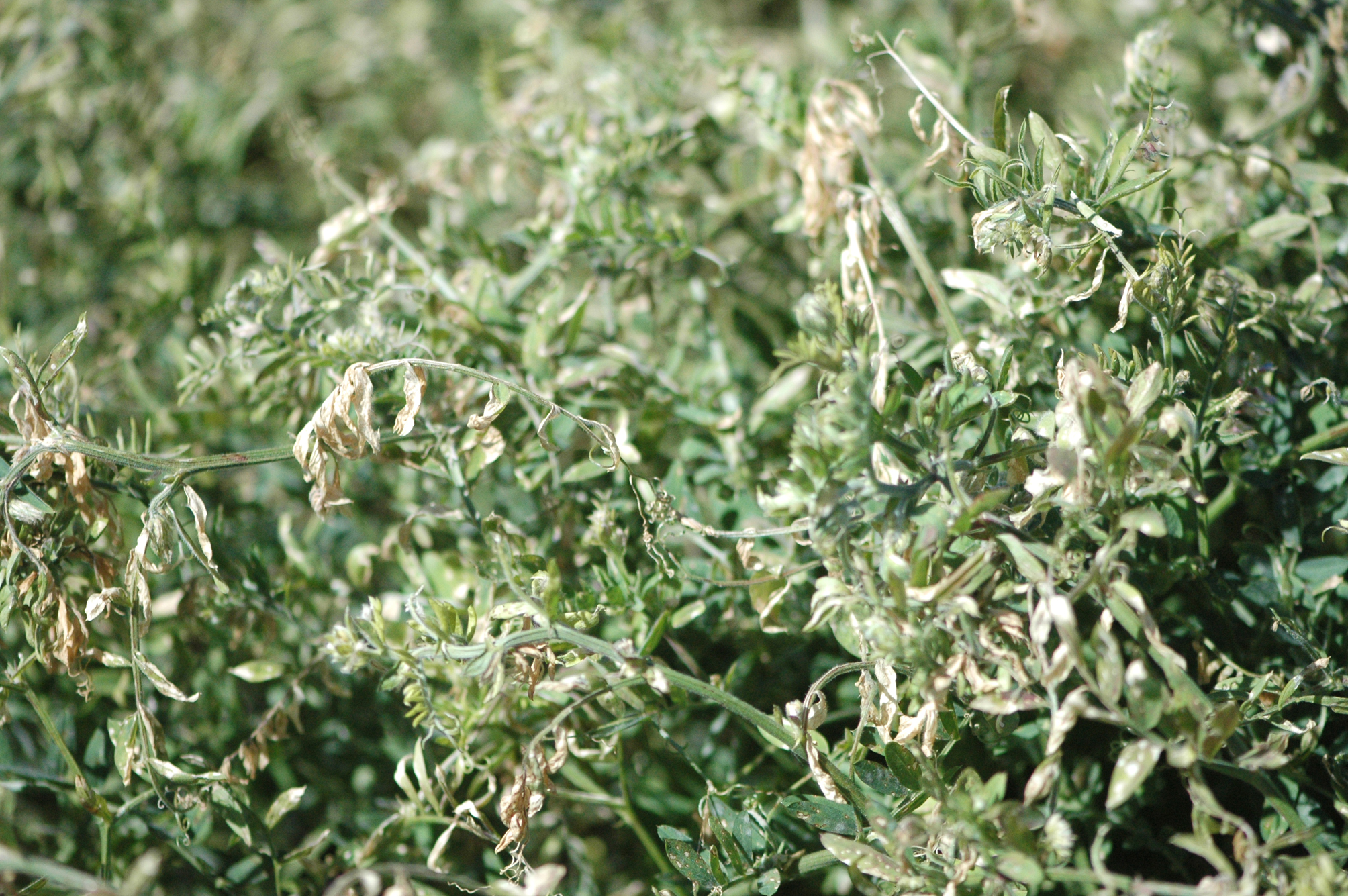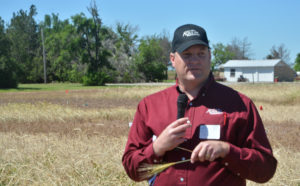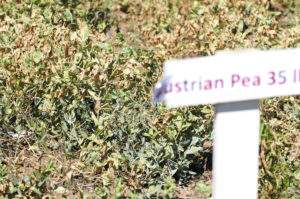Farm & Ranch
[AgriLife Extension] Rotation, cover crops impact cotton yields more than tillage

By: Kay Ledbetter
Writer: Kay Ledbetter, 806-677-5608, [email protected]
Contact: Dr. Paul DeLaune, 940-552-9941 ext. 207, [email protected]
CHILLICOTHE – After eight years of research on no-till advantages and disadvantages with cotton crops, Dr. Paul DeLaune is convinced it’s not as much about the tillage as it is about the cover crop and/or rotation.
Dr. Paul DeLaune discusses cover crops at a recent field day on the Texas A&M AgriLife Research station south of Chillicothe. (Texas A&M AgriLife Communications photo by Kay Ledbetter)
DeLaune, a Texas A&M AgriLife Research environmental soil scientist in Vernon, said he has compared no-till, strip till and conventional till, as well as cotton with a terminated wheat crop in the Rolling Plains.
“What we’ve seen over eight years is you are really not changing carbon levels,” he said. “But we shouldn’t be looking at one thing only. Even though carbon levels aren’t changing, we’ve dramatically changed some soil physical properties.”
With cotton, DeLaune said there’s not much residue, so there is little change in infiltration rates between no-till and conventional till cotton.
“But we have seen a greater infiltration rate where we have a terminated wheat crop – doubled or tripled our infiltration rates,” he said.
While the U.S. Department of Agriculture Natural Resources Conservation Service program sometimes requires a multispecies cover crop to qualify for cost share programs, depending on the county, DeLaune said he has been experimenting with both single and mixed cover crops since 2011.
The monocultures he has researched include Austrian winter field pea, hairy vetch, crimson clover and wheat, and the mixed species included rye, wheat, hairy vetch, turnips and radishes. Cover crops are planted at lower than full seeding rates, which may differ from information seen in other parts of the country, he said.
DeLaune said everyone knows cover crops aren’t free, as there is cost for the seed and use of soil moisture, but the benefits can potentially outweigh the costs over time.
Austrian Pea cover crop on the Texas A&M AgriLife Research station south of Chillicothe. (Texas A&M AgriLife Communications photo by Kay Ledbetter)
“We have maintained our cotton yields. We have seen an increase in our soil nitrogen in the upper 6 inches, particularly following legume monospecies. We have seen a visible response to cotton behind those cover crops.”
He said his team measures neutron probes in all of the cover crop research plots every other week and he has compiled four years of moisture graphs.
“Yes cover crops use water,” DeLaune said. “But some people say cover crops make water. What they are talking about is increased infiltration. We pull soil moisture down by timing of cover crop termination in mid to late April, but if we get rains in May and plant in June, we get a much higher infiltration rate and by planting season, we are back to status quo.”
He said he likes to let the wheat form a head and stem before terminating it, adding that may use a little more water, but that’s what makes the residue, which is the key to protecting the soil surface, building root biomass and subsequently infiltration.
The ultimate goal with cover crops is to build soil structure and make it more functional, he said.
“With cotton on cotton, no-till alone is probably not going to cut it,” DeLaune said. “But we’ve done very well with just a wheat cover crop, that’s a $6 or $8 treatment per acre compared to the $20 to $25 per acre with a mix of some of these species.”
But cover crops alone are not the answer, he said.
“If you are doing continuous cotton, some type of cover crop would be good, but I would encourage a crop rotation,” DeLaune said. “I have data that shows a cotton-sorghum rotation can increase carbon more rapidly, increasing carbon levels in four years under the rotation, whereas we haven’t in eight years with cotton on cotton.”
-30-
Find more stories, photos, videos and audio at http://today.agrilife.org
Farm & Ranch
Hazards of Backyard Poultry

By Barry Whitworth, DVM
Having backyard poultry is a popular agriculture enterprise. According to the United States Department of Agriculture, 0.8 percent of all households in the United States have chickens. People keep chickens for a variety of reasons with table eggs being one of the more common reasons.
Unfortunately, some of these poultry producers are not aware of the hazards that come with keeping poultry because many times they carry pathogens but appear healthy.
Chickens are carriers of several zoonotic diseases. These are diseases that can be passed from animals to humans. According to a recent survey in Pennsylvania, a majority of backyard poultry producers were aware of the dangers of avian influenza. However, this study also revealed that far fewer producers were aware of the risk of possible exposure to Salmonella and Campylobacter.
The lack of knowledge about the hazards of raising poultry likely contributes to the continued issues of Salmonella outbreaks associated with backyard poultry. In 2023, the Centers for Disease Control and Prevention reported 1,072 illnesses of Salmonella linked to backyard poultry, and 272 of those patients required hospitalization. Oklahoma reported 43 individuals with the disease.
To read more, pick up a copy of the April issue of NTFR magazine. To subscribe by mail, call 940-872-5922.
Farm & Ranch
Ag Elsewhere: Wyoming

By Tressa Lawrence
Babies are tucked away in every nook and cranny. Many ranchers across Wyoming have baby animals popping up all over this time of year.
Farm & Ranch
Ag Elsewhere: Montana

By Lindsey Monk
Another load of grain in to keep feeding the calves until the green grass can really start popping.
-

 Country Lifestyles1 year ago
Country Lifestyles1 year agoScott & Stacey Schumacher: A Growth Mindset
-

 Equine7 months ago
Equine7 months agoThe Will to Win
-

 Country Lifestyles7 years ago
Country Lifestyles7 years agoStyle Your Profile – What your style cowboy hat says about you and new trends in 2017
-

 Country Lifestyles4 years ago
Country Lifestyles4 years agoAmber Crawford, Breakaway Roper
-

 HOME7 years ago
HOME7 years agoGrazing North Texas – Wilman Lovegrass
-

 Country Lifestyles7 years ago
Country Lifestyles7 years agoDecember 2016 Profile, Rusty Riddle – The Riddle Way
-

 Country Lifestyles8 years ago
Country Lifestyles8 years agoJune 2016 Profile – The man behind the mic: Bob Tallman
-

 Outdoor9 years ago
Outdoor9 years agoButtercup or Primrose?








